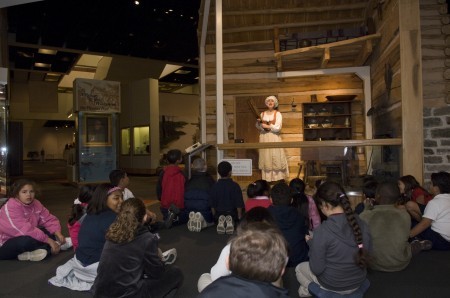Choosing the right title for a museum professional who interacts with the public, especially in an educational role, can be surprisingly complex. The debate over appropriate terminology is a common one within museum circles. The purpose of language is to facilitate understanding and convey ideas effectively. So, what do we call the people who bring museum collections to life for visitors?
 Museum educator interacting with students in front of an exhibit
Museum educator interacting with students in front of an exhibit
Here’s a breakdown of common terms and the nuances associated with each:
Docent: The term “docent” often implies a volunteer role, as highlighted in the AASLH post “Do You Docent?” and Michelle Moon’s “Do We Docent?.” While a respected tradition, this association can be misleading when describing paid, full-time museum staff. Using “docent” may not accurately reflect the professional expertise and responsibilities of museum educators.
Museum Program Assistant (MPA): Government institutions or larger organizations sometimes use this title. While seemingly official, MPA can be misleading. It suggests a supporting role rather than the active creation and delivery of engaging educational experiences. It fails to convey the full scope of responsibilities, including curriculum development, research, and direct instruction. The term “museum program assistant” does little to inspire or communicate the dynamism of the work involved.
Education Specialist: To accurately describe the educators in a museum, “education specialist” is the most focused term. It highlights the specialized knowledge and skills required to develop and deliver educational programs. From creating lesson plans and activities to training teachers, education specialists are dedicated to fostering learning through museum resources. However, this term may not be universally understood outside the field of education.
Interpreter: The term “interpreter” highlights the act of conveying meaning and context to visitors. Museum professionals use artifacts, documents, and exhibits to tell stories and make history accessible. The National Association for Interpretation (NAI) certifies professional interpreters, further legitimizing this title. The disadvantage of the word is that it can be too broad, because many jobs at the museum interpret information. Also, some people might confuse the role of museum “interpreter” with a language translator.
Guide: “Guide” is perhaps the most widely recognized and understood term. It conjures an image of someone leading visitors through exhibits and providing information. “Guide” is an easily recognized term. However, it can sometimes carry a connotation of simply reciting facts without fostering deeper engagement. Visitors might expect a superficial overview rather than an immersive learning experience. Museum educators go beyond pointing out artifacts; they facilitate meaningful connections between objects and audiences.
Ultimately, the “best” term depends on the specific context and target audience. When communicating with educators and academic professionals, “education specialist” may be most appropriate. For the general public, “guide” offers a familiar and accessible point of reference. “Interpreter” speaks to the intellectual work of bringing meaning to the collections. The most important thing is to choose a term that accurately reflects the role and responsibilities of the individual while also communicating effectively with visitors.
What title resonates most with you, and why? Does the specific term we use truly impact how the public perceives our role in museums?
